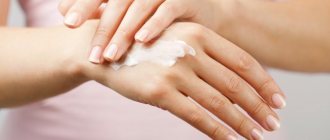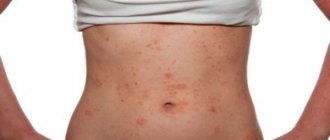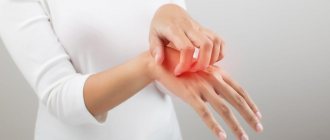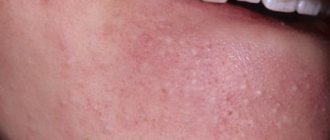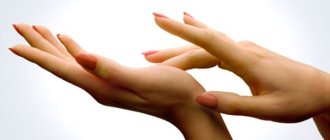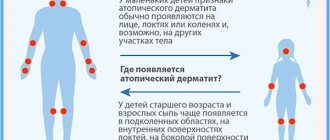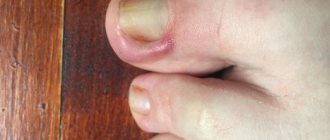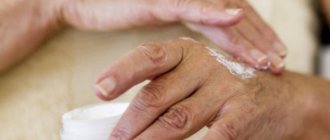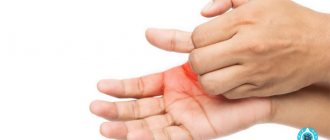Allergy blisters on hands
Allergies are a fairly common phenomenon that can occur in almost anyone.
Very often this allergic process is accompanied by rashes on the body and itching, as well as separately in the form of blisters on the hands
The reasons contributing to the occurrence of allergies in the upper extremities may be:
- exposure to synthetic products - powder, dishwashing detergent, and so on;
- rain and wind, if the person was outside at that time;
- freezing;
- various stressful situations;
- increased sweating;
- allergies to certain foods.
Scabies
If the blisters on your hands are itchy, it may be due to scabies mite infestation. The insect often gets under the skin through the fingers and palms, so the first signs of the disease appear in these areas. Scabies rashes are varied. These are pimples, blisters, red and black dots. Sometimes insects leave characteristic passages in the form of grayish stripes about 1 cm long. The unbearable itching caused by the movement and waste products of mites intensifies in the evening and reaches its peak at night. Scratching is often accompanied by infection. Treatment consists of applying insecticide ointments to the entire body.
Blisters on the hands should never be pressed or punctured. Do not cover them with adhesive tape. If the bubbles do open, you must immediately treat them with an antiseptic solution and regenerating ointment. If the rash spreads or appears regularly, be sure to visit a dermatologist.
Symptoms
Bubbles on hands
You can clearly see the allergy on your hands in the form of bubbles in the photo, where skin manifestations are clearly visible. Bubbles can look very different in shape, color, consistency, location, and so on.
It is worth noting that not only allergies can cause the appearance of allergic blisters on the body, it can also indicate the presence of an infectious or autoimmune disease in the body.
The appearance of blisters on the hands may be accompanied by other symptoms. As a rule, before the formation of allergic blisters, the patient begins to complain of itching and burning of the skin. The skin becomes hyperemic, and after a few days, blisters actually appear.
If the blisters are not scratched, they will heal within a week, but provided that the patient completely eliminates contact with the allergen. If you comb the skin, this will only delay the healing period. In addition, this can provoke the development of ulcers.
Of course, allergies can be completely eliminated if contact with the allergen is eliminated. Therefore, it is imperative to find out what exactly provokes the development of the pathological process.
If you yourself cannot understand the reason, then you should visit a doctor who will help you figure it out and prescribe an effective antiallergic drug. In order to reduce and eliminate the skin reaction, you must do the following:
- reduce the effect of histamine on the body by taking antihistamines. The most popular drugs are: diphenhydramine, claritin, tavegil. You can learn more about these antiallergic drugs on disqus, where users leave their reviews, including about these drugs;
- Taking glucocorticoids will help prevent cell death, which will significantly reduce allergy symptoms. Kenagol and dexamethasone are considered good remedies today. You can also read reviews about them on disqus. This way you can understand which drug is more effective. But, in any case, it is better not to self-medicate, but to follow the advice of a doctor;
- Calcium-based medications will help reduce the permeability of vessel walls, these include calcium chloride and calcium gluconate;
- enterosorbents will help with detoxification of the body.
In addition, if we talk about the treatment of allergies on the hands in the form of blisters, treatment consists not only of taking medications, but also of high-quality prevention. Namely, use hypoallergenic cosmetics, eliminate stressful situations, get rid of bad habits, walk in the fresh air as often as possible and give preference to a healthy lifestyle.
By clicking the “Submit” button, you accept the terms of the privacy policy and consent to the processing of personal data under the conditions and for the purposes specified in it.
Diseases that cause rash
Important! A chemical burn with a blistering rash can be caused by chemical household cleaning products.
- Insect bites. Typically, insect bites become swollen and red, but sometimes blisters with clear liquid form on the skin. Especially if a person has thin skin. As a rule, such blisters appear after sleep or evening walks - mosquitoes bite exposed areas of the body. Also, a person may not notice that he has received a burn from exposure to high temperatures. Blistering rashes can appear due to oil splashes during cooking, sparks hitting the skin, or trying to wash your hands with too hot water.
- Splinters. Bubbles appear due to splinters around which suppuration has accumulated. A large number of bubbles may be due to multiple small splinters. These blisters usually appear a few days after cleaning up broken glassware or woodworking. In rare cases, foreign bodies can remain under the skin for many years and then become inflamed, causing pus-filled blisters to form.
- Calluses. Sometimes the appearance of blisters on the hands is caused by mechanical damage. The skin can be rubbed by the handle of a heavy bag, a rough cloth when squeezing out a cloth, and so on. The size of the calluses may vary, they can cause mild pain, but there should not be itching or an unpleasant odor. In this case, the skin on the blisters is rougher and harder, and a cloudy liquid is observed inside.
Allergy blisters on hands
Hand allergies are one of the most common signs of irritation. The first symptoms appear on the surface of the hands both upon contact with an irritant and in the event of penetration of the allergen inside. Therefore, a skin rash in the form of blisters can appear under the influence of medications, cosmetics and household chemicals, and food. Treatment is prescribed depending on the symptoms.
Allergies on the hands in the form of blisters are called contact allergies.
Why does the reaction occur?
Allergies on the surface of the hands in the form of blistering formations appear when various diseases occur. All of them are allergic in nature. Often a skin rash occurs with atopy. In this case, the allergy is due to a hereditary predisposition. In this case, the person may suffer from:
On the skin of the hands, lesions can occur when these areas come into direct contact with an irritating substance. In this case, a contact allergy is noted. Sometimes an allergen systemically affects the body from the outside or from the inside. In this case, a reaction in the form of bubbles on the hands appears under the influence of:
Lesions on the skin can occur under the influence of various factors. Therefore, treatment will be carried out depending on the nature of the influence.
Blisters on the hands are a consequence of contact with an allergen.
Prevention
Allergies are extremely difficult to treat with medication, so preventing the risk of developing an allergic reaction should consist of a few simple rules.
General recommendations:
- personal hygiene support;
- proper and balanced nutrition;
- regular wet cleaning of the house;
- avoiding contact with aggressive substances.
- the patient is not recommended to have long-pile carpets in the house;
- It is advisable to store books behind glass;
- bedding should not contain natural ingredients;
- It is not advisable to have pets;
- Work in dusty areas should be kept to a minimum.
Any person has ever encountered strange rashes that usually appear on the most exposed parts of the body - limbs, face, neck, and so on.
Moreover, the most common problem among this wide range of neoplasms is a rash on the hands, most often represented by small blisters.
The reasons that caused their appearance can be very diverse - ranging from completely harmless to serious pathological processes in the body.
However, the most common factor that triggers the appearance of a rash is a banal allergic reaction.
Allergy symptoms
The rash on the skin of the hands can be in the form of blisters and red pimples. They may differ in dry and wet manifestations. Allergies are also characterized by:
small or large formations:
Rashes in the form of bubbles can appear both on the fingers and on all surfaces of the hand, reaching the forearm area.
The appearance of formations on the hands may be accompanied by a disturbance in the general condition of the body. A person may feel:
The skin in the area of the blisters may become very inflamed. A burning sensation and local temperature change are felt.
If treatment was started on time and contact with the allergen was completely eliminated, then healing occurs within one week. With constant scratching, the rash takes longer to go away. Scratching the surface of the hands is dangerous, since if the surface of the bubble is damaged, pathogenic microbes can penetrate into the wound.
What distinguishes formations on the surface of the skin of the hands from other types of rashes is the presence of severe swelling. When they appear, it is important to start treatment on time to prevent the development of the disease.
The area of distribution of allergies in the form of blisters is not limited only to the hands.
Allergy treatment
Treatment of hand allergies is carried out by completely eliminating contact with the allergen. If irritation is caused by direct contact with cosmetics or household chemicals, then it is important to replace the products with hypoallergenic ones. If you have food irritation, you should follow a special diet.
Therapy can only be carried out after consultation with a doctor. It is forbidden to prescribe medications yourself. In this case, the allergy may only get worse.
A rash on the hands is treated with ointments and creams that affect the blisters. Among them are:
They help resolve blisters, as well as eliminate itching, redness, and peeling.
It is imperative to take antihistamines. They are able to stop the development of an allergic reaction by stopping the production of histamine. The doctor may prescribe first-generation drugs:
They are effective, but often cause side effects such as drowsiness and impaired concentration. Therefore, they can be replaced with new generation products:
In case of severe lesions on the hands, glucocorticosteroids are used. They help stabilize mast cell membranes. Under their influence, cells are not destroyed and do not release histamine. Among the effective means are:
To reduce the permeability of the walls of blood vessels and strengthen them, calcium-containing drugs are prescribed. In this case, the liquid that fills the bubble does not form. Vitamins A, C, and E have the same effect.
To remove toxic substances from the body, the use of enterosorbents is indicated. They contribute to the collection of harmful elements. For this purpose, the doctor may prescribe:
Allergies in the hands are treated with physiotherapy. Treatment can be carried out as electrophoresis with:
When blisters on the skin burst, it is necessary to lubricate the affected surface with antiseptic agents:
It is also necessary to use agents that relieve inflammation: silver nitrates, Ichthyol ointment, tannin.
To relieve itching, treatment is carried out with Menthol, Anestezin, Diphenhydramine, carbolic, citric and acetic acids.
It is important to remain calm during therapy. Bubbles can form under the influence of stress or nervous tension.
After drug therapy, you need to follow skin care rules. It is worth replacing cosmetics with hypoallergenic ones that help soften and moisturize. It is also necessary to avoid synthetic substances in the composition.
Ointments for itchy skin due to allergies
There are many such means. The best and most effective include:
- Beloderm. The active substance is betamethasone. The ointment is used several times a day until the unpleasant symptom disappears. Beloderm during pregnancy can be used only in especially extreme cases and only after the doctor’s permission. The drug is approved for use by children over 6 months.
- Psilo-balm. The active ingredient is diphenhydramine. There are two restrictions - individual intolerance to the active substance and children under two years of age. During pregnancy, the product can be used under the supervision of a doctor, but during lactation it is prohibited.
- Iricar is a homogeneous ointment for external use. The main component is a mother tincture. The drug is recommended for use for itching in adults and children over one year of age 3 times a day. The course of treatment is 14 days. During pregnancy and lactation, the product is not recommended for use.
- Mesoderm. The main component is betamethasone. The drug has an impressive list of contraindications, so it should be used as a last resort and with great caution.
Remember that if no therapeutic effect is observed when using these drugs, it is recommended to consult a doctor. The doctor will be able to choose another drug. Don't do anything on your own, as you may only make the situation worse.
Main menu
Allergic rashes on the hands are a common phenomenon experienced by a large number of people around the world. There are many reasons why allergies may appear on the skin of the hands of adults and children. We will consider the most common ones in the article.
Possible causes of allergies
When a skin rash occurs, it is important to understand whether it is due to an allergic reaction or another medical condition.
The following signs will help determine the nature of the rash:
- short time for the rash to appear after contact with the allergen. For example, an allergy to the fingers that occurs after contact with an acidic detergent.
- an increase in the size of the spots and the appearance of blisters, accompanied by severe itching.
Allergic contact dermatitis
Allergies on the hands in the form of red spots in adults and children can be caused by contact dermatitis - inflammation resulting from direct contact of the skin with irritants or allergens. In this disease, exposure to a certain substance causes adverse reactions in the body, resulting in the formation of a rash on the surface of the skin.
There are two types of contact dermatitis.
The first and most common is irritant contact dermatitis. This type of dermatitis develops when the skin comes into contact with acids, solvents, soaps, or other chemicals. For example, repeated immersion of hands in any of these substances may result in allergies on the hands and rashes between the fingers.
Allergic contact dermatitis (photo)
The second type is allergic contact dermatitis. In this case, the skin has increased sensitivity to certain substances, such as plants, metals, drugs or other substances. Skin contact with these allergic substances causes an immune response from the body, in which antibodies are produced and histamine is released into the blood, damaging epidermal cells. As a result, allergies may appear on the hands in the form of blisters.
Irritant contact dermatitis (photo)
Contact dermatitis can be caused by substances such as laundry detergent, detergents, latex, soap, antibiotics, nickel and other metals, poison ivy, preservatives, sunscreens, tattoo ink and black henna, etc.
Symptoms may begin 12 to 48 hours later and last two to four weeks after onset.
Dermatitis can be recognized by the following signs:
- red spots on the skin and between the fingers
- blisters and wounds accompanied by severe itching
- dry, flaky areas of skin
- "burning" painful skin
Allergic urticaria
The occurrence of urticaria can be triggered by food, plant pollen, medications, animal epidermis, insect bites, etc. It is worth noting that an allergy to cold on the hands also manifests itself in the form of urticaria.
The main symptom is itchy pinkish-red rashes on the hands, which can be distributed either singly or multiplely, merging into large spots.
Allergic urticaria (photo)
As a rule, urticaria spreads simultaneously to different parts of the body. For example, with a drug allergy, allergies may occur in the arms and legs.
Allergies in a child’s hands in the form of urticaria are a common occurrence that most often occurs as a result of a food or insect allergy (to poison and insect bites).
The inability of the digestive system of infants to digest certain foods, such as citrus fruits, sweets, nuts, etc., can provoke allergic rashes that are localized, including on the child’s cheeks, knees, elbows, feet, etc.
Allergy in the hands of a child (photo)
The second common cause is insect bites.
In some cases, the allergic reaction is local in nature: urticaria appears, accompanied by severe itching. Children often scratch the bite sites, thereby causing even more harm: the skin rash begins to ooze and becomes susceptible to infection. Therefore, parents should ensure that this does not happen and use medications to eliminate itching.
As a rule, an allergic reaction in the hands in the form of hives goes away within 24 hours.
Hives
It is often the cause of red blisters on the hands. This is an allergic reaction to food and certain medications. Exacerbations are usually triggered by stress. Accompanied by the appearance of swollen red spots with itchy blisters. The lesions are similar to nettle burns. The acute form is treated with antihistamines. It is also necessary to identify and eliminate the source of allergens. The chronic type of urticaria involves taking hormonal drugs and immunosuppressants.
Diagnostics
To identify the cause of the disease, the allergist prescribes skin patch tests. This test is used primarily to detect skin allergies. The essence of the test is to wear patches on the skin of the back, treated with allergens for 48 hours. After this period of time, the doctor assesses the body’s reaction: if irritation and itching occur at the site where the patch is attached, the allergen has been identified, and a course of treatment is prescribed.
Patch skin test
Laboratory methods are also carried out to test blood for immunoglobulin E, which will confirm or refute the involvement of allergies in skin rashes.
Treatment methods and preventive measures
It is important to consult a doctor promptly and follow preventive measures to protect the skin.
The first thing to do in order to cure an allergy is to limit further contact with the irritant.
- When handling household chemicals, be sure to use protective vinyl gloves. But don't wear them for long periods of time, as sweating under gloves aggravates hand allergies.
- Completely avoid touching allergens that have been identified using patch tests.
- When washing your hands, use baby soap.
- To prevent cold allergies on your hands from taking you by surprise, take measures to protect your skin. Wear gloves and use moisturizer to prevent skin chapping and irritation.
Remedies for hand allergies
In the event that an allergy occurs on the hands, treatment should be carried out using ointments and antihistamines.
Taking antihistamines will eliminate itching, including between the fingers. These drugs include tablets: Zodak, Claritin, Erius, etc. and ointments: Fenistil gel, Psilobalm, Fladex.
Antihistamines for hand allergies
In some cases, as prescribed by a doctor, a corticosteroid (hormonal) ointment for hand allergies is used, which has an anti-inflammatory effect: Hydrocortisone, Advantan, Akriderm, Triderm, etc.
Hormonal ointments for allergies
To prevent dryness and flaking of the skin on the hands, emollient creams are used.
They create a protective layer in the form of a film and also help retain moisture in the skin. Allergy between the fingers thanks to the use of these products causes a person much less discomfort. These drugs include: Locobase, Emolium, Topicrem, etc.
Cream to protect the skin from external irritants
Sorbents are also used to remove allergens from the body: activated carbon, Polysorb, Carbopect, etc.
